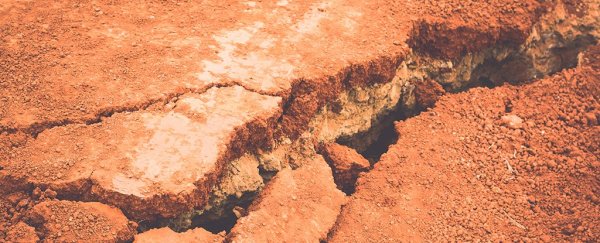Researchers in the US have found a link between the position of the Sun and Moon and small tremors deep within the San Andreas Fault - suggesting that the gravitational pull of the astronomical bodies could be causing the Earth's plates to move up and down like the ocean's tides.
The findings also suggest that the geological region is a lot weaker than previously thought.
But the good news is that understanding these small tremors, known as low-frequency earthquakes, might lead to a better way of monitoring the fault itself, which lies roughly 32 kilometres (20 miles) underground.
"It's kind of crazy, right? That the Moon, when it's pulling in the same direction that the fault is slipping, causes the fault to slip more – and faster," team leader Nicholas van der Elst, from the US Geological Survey, said in a statement.
"What it shows is that the fault is super weak - much weaker than we would expect - given that there's [32 km] (20 miles) of rock sitting on top of it."
In case you need a refresher, the San Andreas Fault – which stretches some 1,287 kilometres (800 miles) through California – is a geological region where the Pacific Plate and the North American Plate meet. Since the Earth's tectonic plates are always in motion, they grind together, leading to regular, but often tiny, earthquakes.
While researchers have long studied the fault and have even been keeping tabs on its small tremors – which are basically micro-earthquakes that register around 1.0 in magnitude - emanating deep within it, the US team is the first to show that tidal shifts also affect the fault, and could be causing these tremors.
To come to that conclusion, the team analysed 81,000 low-frequency earthquakes that occurred between 2008 and 2015 near the Parkfield section of the fault – an area that is constantly jittering with seismic activity.
They then compared this data to tidal data from the same timeframe, paying particularly close attention to the two-week 'fortnightly tide', which coincides with the lunar cycle.
When all was said and done, the team found that seismic activity in the region increased when the Moon was in its waxing phase, building up to a full Moon.
Of course, correlation doesn't equal causation, and the study didn't look into how the Moon and Sun could be influencing earthquake frequency.
But the team hypothesises that this link could be due to the fact that the Sun and Moon align around the waxing phase of the Moon, causing a greater than normal gravitational pull on the Earth.
For our oceans, that means that high tide gets higher and low tide gets lower – and the researchers think it could also make seismic activity along fault lines more likely, too.
Though the new findings could add to a longstanding debate over the connection between tides and earthquakes, the team says the real impact is that it offers a new way to monitor how much 'slip' is happening along the fault by acting as a natural laboratory.
"It's almost like having a lot of little creep meters embedded in the fault," team member David Shelly told Rosanna Xia from the Los Angeles Times.
"We can use these low-frequency earthquakes as measurements of, at least in a relative sense, how much slip is happening at each little spot on the deep part of the fault where we see these events. When we don't see them, we don't know what's happening; we don't know whether it's slipping silently or not slipping at all."
Basically, this means that the team has found a way to check how much movement is happening in the deeper sections of the fault, which could help them predict how much movement will happen towards its top.
In other words, it might help them predict potentially dangerous earthquakes.
"So if all of a sudden, we saw that the deep part of the fault was slipping a huge amount, it might be an indication that there was an increased chance of having an earthquake come at the shallower part of the fault," continued Shelly.
The best way to think about this is to picture a huge, coiled spring. With every deep movement in the fault, the spring gets wound down more and more. Eventually, all of the tiny movements will build enough tension to unleash that spring, releasing a massive amount of energy in the form of an earthquake.
So, when will the San Andreas Fault be wound tightly enough to trigger a major earthquake? Well, according to a keynote talk given by the Southern California Earthquake Centre's director Thomas Jordan back in May, probably pretty soon.
"The springs on the San Andreas system have been wound very, very tight. And the southern San Andreas Fault, in particular, looks like it's locked, loaded and ready to go," Jordan said while addressing the audience at the 2016 National Earthquake Conference in Long Beach.
Hopefully, the new study will allow researchers to get a better grasp over when these gigantic earthquakes might happen, but we won't truly know for sure until one does.
The new findings were recently published in the journal Proceedings of the National Academy of Sciences.
